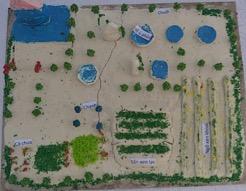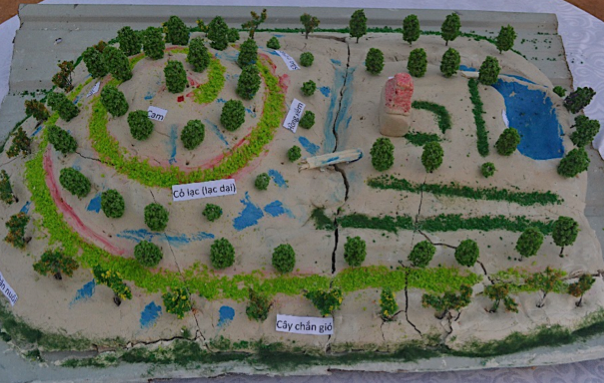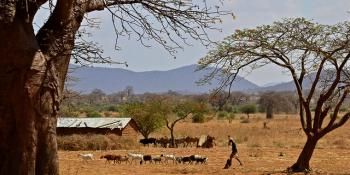Models for a better future: Climate-smart agriculture is spreading

Lessons learned and opportunities for bringing climate-smart practices to scale were shared among the participants of a climate-smart agriculture event in My Loi village, Vietnam.
Farmers, community members and local leaders gathered in My Loi Climate-Smart Village (CSV) in Ha Tinh province, Vietnam, to share lessons learned and future opportunities for expanding climate-smart practices throughout the region and beyond. The knowledge-sharing session was one of the activities for the climate-smart agriculture (CSA) event in My Loi, which was supported by the CGIAR Research Program on Climate Change, Agriculture and Food Security (CCAFS) in Southeast Asia.
The main difficulties facing farmers in this region are related to soil erosion and degradation, as well as unpredictable seasonal weather patterns. Photographs taken by farmers were shared, many of which depicted images of flooding damage caused by severe storms in recent years. Le Cong Uan, a farmer from My Loi Village concerned about erosion stated, “Landslides will cause the area of cultivated land to shrink”. Hi Minh Hieu shared an image of how “the 2015 drown (sic) the bridge and people were unable to walk.”
These images highlighted the need for diversified production and environmental resilience. Mr. Tham, head of My Loi village, emphasized the importance of raising climate change awareness and its impacts at the local level, saying that “CSA practices can help reduce negative impacts on farmers’ livelihoods and agricultural production in particular.”
To devise climate-smart solutions to these challenges, twelve farmers divided into four groups, and built and presented 3D models for agroforestry systems. The models represent CSA practices which they believed to be promising for the area.
1. Native species and worms
The home garden model group suggested using native timber species as pillars for pepper crops, efficient resource cycling using livestock manure and crop residue in a vermiculture system, diverse vegetables fertilized with vermicompost, and agarwood windbreak along the edges.
“Utilizing wastes produced from agriculture and animal raising will help farmers save in the costs of production and reduce environmental pollution,” said Mr. Duong Thanh Hai, one of the designers of this model.
The group also presented the Mac tree as a suitable living pillar for pepper, thus reducing the need to harvest trees from the forest. The tree is also a better alternative to cement pillars.

This model involves native timber species as pillars for pepper crops, efficient resource cycling, and agarwood windbreak along the edges. This would save on costs for farmers. Photo: Abigail Smith (ICRAF)
2. Mixed food crops
The intercropping model showed combinations of sweet potato-maize and cassava-peanut. Livestock production was improved using effective microorganism (EM) products and vermiculture for composting, and energy was captured for household use through biogas. The blue represents the composting hole, vermiculture enclosure and livestock sties.
Beneficial EM cultures improve the efficiency of decomposing livestock wastes, thereby reducing the noxious smells and improving the hygiene in the sty.
“Intercropping cassava and peanut has been implemented for many years in our village, and it is very good one to maximize the outputs in one specific land area and the components provide complementary benefits to each other. Peanut, for example, can fix nitrogen in the soil, prevent soil moisture loss and its residue can be used as green manure to increase soil fertility,” said Van Thi Lai, who helped to build this model.

This model shows combinations of sweet potato-maize and cassava-peanut. As it has been implemented in the past, the farmers know the benefits of this system. Photo: Abigail Smith (ICRAF)
3. Trees on slopes
One agroforestry strategy for sloping land included orange and pomelo arranged in a spiral pattern with Arachis pintoi forage to prevent erosion. Other fruit trees were integrated into the landscape for production, such as durian and guava, and Dracontomelon duperranum as windbreaks. The spiral pattern improves water retention and prevents erosion on the sloping land, and also saves time and energy for farmers walking up the hill when tending the trees.
“I planted monoculture of cassava which required inputs every single year, caused soil erosion and degradation. Now, I have converted 1.2 ha of cassava to fruit trees in spiral pattern which is similar to contour planting, with Arachis pintoi and applied drip irrigation and pond to store water. I believe that this practice will provide higher income, adapt to drought and reduce soil erosion and soil moisture loss,” said Mr. Duong Duc Thai, a representative of agroforestry model group.

One agroforestry strategy for sloping land included orange and pomelo arranged in a spiral pattern with Arachis pintoi forage to prevent erosion. This model is similar to contour farming. Photo: Abigail Smith (ICRAF)
4. Spiraling tea
This agroforestry tea plantation model integrated fruit trees such as longan and lychee with forage grasses, medicinal plants including ginger, lemongrass and tangerine, and a pond as water source. While reducing erosion and maintaining water filtration on this sloping land, this system diversified the economic risk for the farmer.
“Planting native trees such as jackfruit and Tac (a local mandarine) on the top of the hills together with countour plantation of tea in one side and fruit (longan and lychee) trees in other side will maintain water source for the lower area,” said Mr. Pham Huy Hoang, spokesman for the fourth modeling group. He added annual crops will provide short-term benefits to farmers while waiting for income from tea or fruits.

This model integrates tea plantations with fruit trees with forage grasses, medicinal plants, and a pond as water source. This will maintain the water resources for the lower areas. Photo: Abigail Smith (ICRAF)
The farmers’ models highlight the importance of efficient resource cycling and integrating diverse crops and trees. These systems maximize beneficial outcomes such as microclimate regulation, erosion prevention, and improvement of soil moisture and fertility. The strategies of diversification, planting for erosion prevention, symbiotic crop pairings and resource cycling can be implemented in Ky Son or Ky Anh communes to improve productivity and resilience, or adapted for more general application in other areas based on topographical and climate factors.
The applicability and policy support for these models as well as CSA practices in general were discussed at the event. Over 160 individuals attended the CSA event, with television and print media coverage reaching many more. The provincial, district and commune leaders provided information on the potential of future scaling for CSA practices through integration of CSA into future socio-economic, agricultural, and rural development plants at various levels. Ms. Nguyen Anh Ngoc, leader of Ky Son Commune People committee, said: “There are potentials to integrate CSA approach into socio-economic and rural development plans of the commune because we can see some mutual benefits of these activities.”
Farmer-to-farmer networking appears promising based on preliminary feedback from the event, with many attendees citing opportunities for improving resilience and resource efficiency on their own farms. Training events and support groups will continue to support broader adoption of CSA practices through farmer social networks.
My Loi is one of the six CSVs in Southeast Asia supported by CCAFS, which aims to develop climate-smart farming techniques. Read more about the Climate-Smart Village project.
For more information about Photovoice methodology, click here.
For local media coverage from a Ha Tinh newspaper, click here.
Read more:
- “Please share!” – Social learning leads to greater adoption of climate-smart agriculture
- Worms as nutrients for animals and soil
- Barren no more: farmers restore forest landscape
Abigail Smith is a Master of Environmental Management student at Yale School of Forestry & Environmental Studies. She is currently working as a Research Communications Fellow at the World Agroforestry Centre (ICRAF Vietnam).



